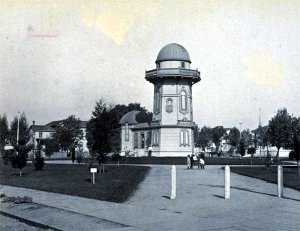 The original Oakland Observatory in the 1880’s,
The original Oakland Observatory in the 1880’s,
at Lafayette Square in Oakland. Credit: Chabot Space
& Science Center archives.This year marks an anniversary for the astronomical heritage of Oakland and the San Francisco Bay Area: Chabot Observatory turns 125!
Originally established as the Oakland Observatory in 1883, the facility was a unique creature from the very beginning. Conceived by then Oakland Public Schools Superintendent Jewett Gilson, who was inspired by a school observatory he saw in Philadelphia, the observatory was created for use by Oakland schools and the general public at large.
Gilson looked for, and eventually found, a donor to fund the observatory project: Anthony Chabot, a wealthy entrepreneur and philanthropist who made his fortune building municipal water systems in the Bay Area-- including Lake Temescal and Lake Chabot. Anthony Chabot stipulated as part of his original $3,000 gift that the telescope shall forever be available for public observation at not cost-- a tradition that continues today.
Chabot didn't want the observatory to be named for him, so in its earliest years it was called the Oakland Observatory. The public, as the story goes, insisted on calling it Chabot Observatory in gratitude for the gift-- and eventually the name was made official.
The original location for the observatory and its 8-inch Alvan Clarke and Sons telescope ("Leah") was close to downtown Oakland in Lafayette Square-- which today remains a square block of parkland, at 10th and 11th Streets and Martin Luther King Junior Way and Jefferson Street. In those days, 10 or so visitors on any given night would climb the tower-like structure to the telescope dome and peer at the heavens through the high quality instrument. Reservations had to be made in advance-- sometimes as long as a month or two.
